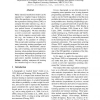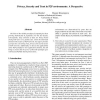1728 search results - page 37 / 346 » Self-Organisation: Paradigms and Applications |
EMNLP
2009
13 years 6 months ago
2009
Many statistical translation models can be regarded as weighted logical deduction. Under this paradigm, we use weights from the expectation semiring (Eisner, 2002), to compute fir...
ICSE
2007
IEEE-ACM
14 years 8 months ago
2007
IEEE-ACM
In the mid-nineties, mobile code was on the rise and, in particular, there was a growing interest in autonomously moving code components, called mobile agents. In 1997, we publish...
DEXAW
2006
IEEE
14 years 11 days ago
2006
IEEE
The Peer-to-Peer (P2P) paradigm of computing has been growing dramatically in popularity over the last decade. Consequently, large amounts of data are being shared among P2P users...
CODASPY
2011
13 years 8 days ago
2011
Social Network Systems pioneer a paradigm of access control that is distinct from traditional approaches to access control. Gates coined the term Relationship-Based Access Control...
FIW
2007
13 years 10 months ago
2007
The rise of communicating devices has led to more and more machine to machine applications. In this context devices can be modeled using serviceoriented computing. Furthermore serv...


